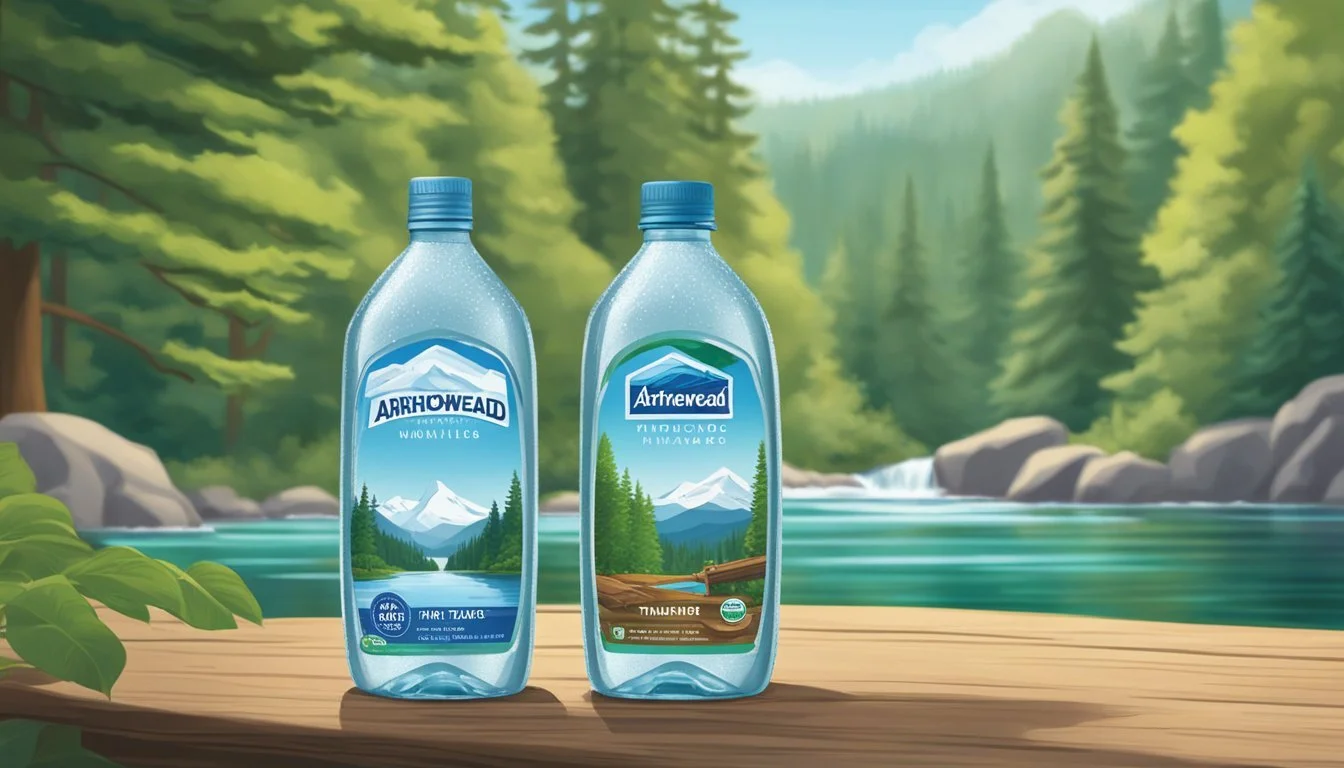Arrowhead vs. Tahoe
Which Bottled Water is Better and Why?
When it comes to choosing bottled water, consumers often compare options to find the best taste and quality. Arrowhead and Tahoe are two popular brands that frequently come under scrutiny. In a direct comparison, Tahoe generally offers a crisper and cleaner taste, making it a preferred choice for many consumers who prioritize taste.
Arrowhead, sourced from springs primarily in the Western United States, is known for its distinct mineral content. Some consumers appreciate the unique flavor profile that these minerals provide, while others might find it less appealing. In contrast, Tahoe, sourced from pristine alpine springs, prides itself on a more neutral and refreshing palette which tends to appeal to a broader audience.
Understanding these differences can help bottled water enthusiasts select the product that aligns best with their personal preferences. Exploring what each brand brings to the table will give consumers more clarity in making an informed choice.
The Essence of Bottled Water
Bottled water comes in various forms, each with its distinct qualities. These categories include spring water, purified water, mineral water, and even regular tap water that has been bottled.
Spring water is sourced from natural springs, and it is often prized for its natural mineral content and lack of processing. This type of water typically undergoes minimal filtration to remove any impurities.
Purified water undergoes extensive filtration and purification processes. These can include distillation, deionization, or reverse osmosis. The result is water that is free from contaminants but also stripped of beneficial minerals.
Mineral water contains a higher concentration of specific minerals, such as calcium and magnesium. These minerals are naturally occurring and must be present at consistent levels to classify the water as mineral.
Tap water, while not typically bottled for commercial sale, is still a relevant category. Some bottled waters are, in fact, tap water that has been filtered and purified before bottling.
The pH level of bottled water can vary widely. For instance, some waters like Arrowhead may have a more acidic pH level, while others strive for neutrality.
When comparing different bottled waters, it is crucial to consider taste, mineral content, and source. Some consumers prefer the taste and minerals of spring water, while others may opt for the ultra-purity of purified water.
The industry itself has seen significant growth. Between 2010 and 2020, bottled water sales surged globally. This boom illustrates the increasing consumer preference for convenient and reliable hydration options.
Brand Profiles
This section highlights the origins, recognition, market position, and quality associated with both Arrowhead and Tahoe bottled water brands.
Arrowhead: Origin and Recognition
Arrowhead sources its water from natural springs located predominantly in the West Coast of the United States. Known for its clean taste, Arrowhead has built a significant reputation over the years.
The brand's water is often lauded for its balanced mineral content, contributing to its distinct, mild flavor. Arrowhead is easily recognized and widely available in supermarkets and grocery stores across the country.
Despite facing some criticism about the plastic used for its bottles, the brand maintains a loyal customer base, who trust its consistent quality. In blind taste tests, Arrowhead has occasionally garnered mixed reviews but continues to perform well due to its accessibility and price point.
Tahoe: Brand Overview and Market Position
Tahoe bottled water originates from the pristine surroundings of the Lake Tahoe area. The brand prides itself on purity, stressing that its water undergoes minimal processing to maintain its natural mineral composition.
Tahoe leverages its geographical origin to appeal to consumers seeking high-quality, pure bottled water. Its marketing often emphasizes sustainability and environmental responsibility, aligning with growing consumer trends toward eco-friendly products.
Though less ubiquitous than Arrowhead, Tahoe has carved out a niche market among health-conscious and environmentally aware consumers. Tahoe’s bottled water generally receives favorable reviews for its taste and purity, positioning it as a premium option in the bottled water market. Its market presence, while not as widespread, is robust in specialty stores and select supermarkets.
Water Source Analysis
When comparing Arrowhead and Tahoe bottled waters, it's essential to evaluate the origins of their water sources and consider both natural springs and groundwater and the environmental impact of their aquifers.
Natural Sources: Springs and Groundwater
Arrowhead primarily sources its water from natural springs located in the San Bernardino Mountains, which are known for their pure and crisp taste.
Tahoe, on the other hand, draws its water from the pristine groundwater sources around Lake Tahoe. Groundwater sources are often filtered naturally through layers of rock and soil, ensuring high quality.
Natural spring waters are praised for their mineral content and refreshing flavors. Both brands emphasize their water's purity, tapping into sources that are naturally filtered.
The Role of Aquifers and Environmental Impact
Aquifers play a crucial role in maintaining the water levels of both Arrowhead and Tahoe.
Arrowhead's reliance on aquifers in the San Bernardino area has raised environmental concerns due to potential over-extraction and impacts on local ecosystems. They take measures to ensure sustainable water use and minimize environmental disruption.
Tahoe’s groundwater extraction near Lake Tahoe is managed to ensure environmental sustainability.
Careful monitoring of extraction practices is vital to maintaining the delicate balance of these ecosystems. Both brands aim to be environmentally friendly and emphasize responsible sourcing practices to protect their natural habitats.
Purification and Enhancement Processes
Arrowhead and Tahoe employ different techniques to ensure the purity and quality of their bottled water. This section examines the specific methods used by each brand to purify water and enhance its characteristics, such as electrolyte addition and pH balancing.
Reverse Osmosis and Filtration Techniques
Arrowhead:
Arrowhead uses a series of filtration methods to maintain the quality of its natural spring water. While the company doesn't prominently advertise use of reverse osmosis, they do utilize other advanced filtration techniques to eliminate impurities without compromising the natural mineral content. These processes ensure that the water is clean and safe for consumption while retaining its unique taste.
Tahoe:
Tahoe, on the other hand, employs reverse osmosis as a primary purification method. This technique is effective in removing a wide range of contaminants, ensuring that the water is exceptionally pure. By pushing water through a semi-permeable membrane, reverse osmosis eliminates bacteria, viruses, and dissolved solids. This meticulous process yields water of high purity, catering to consumers seeking reliably clean hydration.
Electrolyte Addition and pH Balance
Arrowhead:
Arrowhead focuses on maintaining the natural balance of minerals inherent in its spring water source. They do not typically add electrolytes or adjust the pH artificially. This means drinkers experience water that closely resembles its original state in nature, complete with naturally occurring minerals that enhance both hydration and flavor.
Tahoe:
Tahoe enhances its purified water by adding a blend of electrolytes, aiming to improve both taste and hydration potential. Additionally, they carefully balance the pH level to ensure it falls within an optimal range. By doing so, Tahoe caters to modern consumers who favor water products designed with both performance and taste in mind. This practice emphasizes both the scientific approach and consumer preferences in bottled water production.
Taste and Health Considerations
When choosing between Arrowhead and Tahoe, it's essential to consider both their taste profiles and the health benefits associated with their mineral content and hydration properties. This section examines how each brand's water stands out in these areas.
Water Taste Profiles and Preferences
Arrowhead is known for its distinct, slightly mineral taste, which can be polarizing.
Some people appreciate this flavor, finding it refreshing and natural. Tahoe, on the other hand, offers a more neutral taste that appeals to those who prefer their water to have minimal flavor.
In blind taste tests, Arrowhead often divides opinions, whereas Tahoe tends to be more universally acceptable. Consumer preferences indicate a preference for clear and clean-tasting water, but others enjoy a touch of natural mineral essence just like Arrowhead.
Health Benefits of Hydration and Mineral Intake
Proper hydration is crucial for overall health, and both Arrowhead and Tahoe offer bottled water that helps maintain this.
Arrowhead's water is sourced from multiple springs, ensuring it’s rich in natural minerals like calcium and magnesium, which can enhance health. These minerals support bone health, muscle function, and overall physical wellness.
Tahoe’s water is also beneficial but generally has fewer distinct minerals compared to Arrowhead. It provides straightforward hydration without the additional mineral content.
Both brands ensure safety and purity, but mineral-rich Arrowhead offers a slight edge for consumers seeking both refreshment and nutritional benefits.
Packaging and Sustainability
Arrowhead and Tahoe are evaluated on their packaging choices, focusing on the environmental impact of plastic and glass materials, and their steps towards eco-friendly solutions.
Plastic versus Glass: Environmental Trade-offs
Arrowhead primarily uses plastic bottles, which are lightweight and less energy-intensive to produce. However, plastic waste poses significant environmental challenges, contributing to ocean pollution and taking hundreds of years to decompose.
In contrast, Tahoe opts for glass bottles. Glass is fully recyclable and doesn’t degrade over time, making it suitable for multiple reuses. On the downside, glass production is energy-intensive, and its heavier weight increases transportation emissions, offsetting some of its sustainability benefits.
Both brands face trade-offs between production energy and waste management.
The Push for Eco-friendly Packaging
Arrowhead has started introducing bottles made from 50% recycled plastic, aiming to reduce their carbon footprint. They are also exploring biodegradable materials, attempting to decrease environmental harm.
Tahoe, committed to sustainability, uses glass bottles, which, while more ecologically demanding to produce, offer longevity and are easier to recycle. They advocate for reusable bottle programs, encouraging consumers to refill rather than dispose.
These initiatives highlight each brand’s dedication to improving their environmental impact through packaging innovations and responsible practices.
Market Presence and Consumer Choice
Tahoe and Arrowhead bottled waters have distinct positions in the market, which influence where they can be found and how consumers perceive them. Each brand leverages its specific strengths to attract loyal customers in both grocery stores and convenience settings.
Availability in Retail: Convenience Stores and Groceries
Arrowhead enjoys widespread availability across the United States, particularly in the western regions. Major grocery chains and convenience stores frequently stock this brand due to its popularity and strong brand presence.
Tahoe, though newer to the market, is rapidly expanding its footprint. It targets premium grocery stores and select convenience stores, aiming to carve out a niche among discerning water drinkers with its emphasis on purity and high mineral content.
Both brands utilize strategic partnerships with major retailers to ensure they are easily accessible. Arrowhead's longstanding agreements with chains like Walmart and 7-Eleven ensure its ubiquitous presence. Tahoe focuses on boutiques and health-conscious markets.
Consumer Loyalty and Brand Trust
Consumers of Arrowhead tend to value the brand's long history and consistent quality. Its reputation for reliability translates into strong consumer loyalty, particularly in regions where it has been a staple for decades.
Tahoe appeals to a different segment, primarily those interested in premium and artisanal water. Its rigorous sourcing and bottling processes garner trust among health-oriented consumers who prioritize purity and natural mineral content.
Brand trust for Arrowhead is often supported by its visibility and longstanding market presence, which reassures customers. Tahoe builds its reputation through transparency about its sourcing practices and the unique characteristics of its water.
Both brands thus maintain dedicated followings, each appealing to distinct consumer sensibilities while striving to establish trust through their respective strengths.
Comparative Analysis
Arrowhead Mountain Spring Water and Tahoe Mountain Spring Water each cater to different consumer preferences based on price and perceived quality. These aspects are crucial in determining which brand offers better value and satisfaction.
Price Point and Value Proposition
Price varies significantly between Arrowhead and Tahoe. Arrowhead is known for its affordability, frequently found at lower prices per bottle in various supermarkets and large retail chains.
Tahoe Mountain Spring Water commands a higher price, attributed to its premium positioning in the market.
Consumers seeking cost-effective options lean towards Arrowhead, valuing the lower expenditure for daily consumption.
Those prioritizing exclusivity and a higher perceived water quality might prefer Tahoe, accepting the added cost for the brand's premium status.
Flavor and Quality in Consumer Perception
Flavor and quality often define consumer loyalty. Arrowhead and Tahoe have distinct differences in these areas.
Arrowhead's taste is frequently described as clean with a distinctive mineral profile, derived from its mountain spring sources.
Some consumers perceive this as a unique advantage, while others may find it less appealing.
Tahoe Mountain Spring Water prides itself on its crisp, smooth flavor, often praised for its refreshing quality.
Reviews suggest that its subtler taste resonates well with individuals preferring a more neutral water profile.
Consumer perception thus heavily depends on personal preferences for taste and the perceived quality of the water each brand offers.
Concluding Insights
When comparing Arrowhead and Tahoe bottled water brands, several points emerge.
Best Water: Many taste tests and reviews, such as one conducted by The California Aggie, often place Arrowhead in lower tiers. In contrast, Tahoe water is typically praised for its crisp and clean taste, often emphasized by its reputation for sourcing from pristine locations.
Tips: For those who prioritize mineral composition, Tahoe tends to offer a more balanced mineral content, making it preferable for people looking for water that is both refreshing and beneficial. Arrowhead water, on the other hand, is often criticized for its inconsistent taste, which can vary by batch and source.
Bottom Line: Choosing between Arrowhead and Tahoe depends on personal taste preferences and specific water needs. If consistent quality and a cleaner taste are priorities, Tahoe is likely the better option. Arrowhead might appeal to those who prefer water with a distinct mineral profile but should be approached with a discerning palate.








